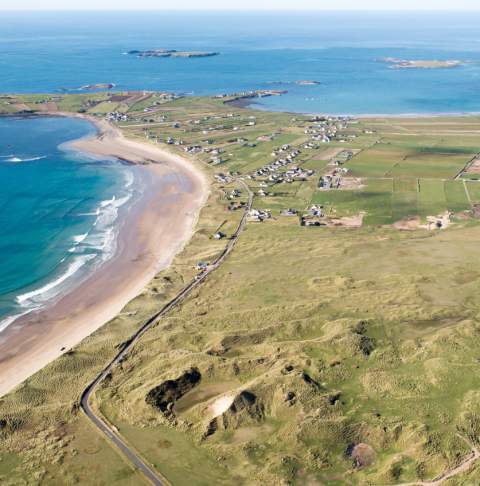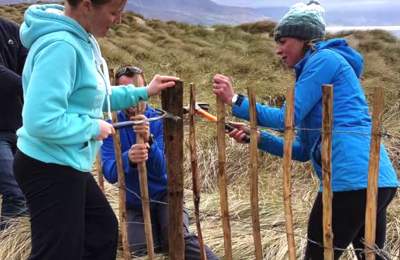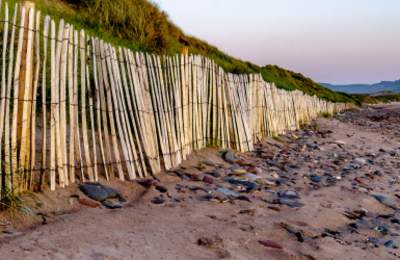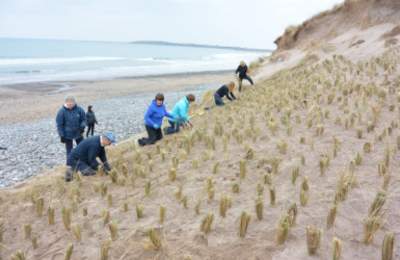The Maharees Archipelago
Situated on the north of the Dingle Peninsula / Corca Dhuibhne the Maharees is a special type of coastal area and one of the best examples of a tombolo. It is framed by an archipelago (a cluster of islands) to the North, known locally as the ‘seven hogs’.
It is situated within an 11,000 hectare Special Area of Conservation, stretching from Tralee town to Brandon Point, spanning over 25 km of coastline, making up an extensive complex of coastal habitats supporting a rich variety of wildlife. The wider area of the Maharees and Tralee Bay is an internationally important wetland for wintering birds. Local conservation groups actively promote awareness amongst walkers to ensure the careful understanding of the delicate balance faced by birds and wildlife habitats. For those adventurers staying nearby, the conservation group also promote the good practice of staying at official campsites - see our guide to Camping & Caravan sites on the Dingle Peninsula / Corca Dhuibhne.
BIRD & WILDLIFE HABITAT
The Maharees is of particular importance to wildfowl species such as Whooper Swan, internationally important numbers of Light-bellied Brent Goose, and nationally important numbers of Shelduck, Wigeon, Teal, Mallard, Pintail and Scaup. Shoreline and wading species of importance include Oystercatcher, Ringed Plover, Golden Plover, Grey Plover, Lapwing, Sanderling, Dunlin, Black-tailed Godwit, Bar-tailed Godwit, Curlew, Redshank and Turnstone.
The area is designated for protection under the EU Birds Directive as it regularly holds over 20,000 birds. For example, over to the west of the Maharees in Brandon Bay, birds of more exposed coasts and the open sea can be seen, including Gannets, Kittiwakes, Manx Shearwaters and Great-northern divers. Thousands of Common Scoter regularly spend the winter in the Bay.
Visitors should be aware that many of these birds must forage all available hours to achieve breeding condition, and regular disturbance by walkers or dogs puts them at risk. This is especially true for migratory species like geese that overwinter on Irish coasts.
Community-Led Conservation
The sand dunes of the Maharees are environmentally sensitive areas which support a variety of wildlife, and the marram grass which stabilizes the sand dunes is fragile. The Maharees archipelago is also extremely vulnerable to the effects of climate change, due to its exposure to Atlantic storms and the low-lying nature of much of the land form. The award winning community and volunteer led Maharees Conservation Association is an internationally recognised exemplar in community-led climate adaptation and successful community-deployment of nature-based solutions. With help from the local authority, Kerry County Council, state agencies, NGOs and academics, a series of community-driven efforts using nature-based solutions, supported by regenerative tourism, the activities of the group are making a difference.
By raising awareness about the unique heritage of the Maharees through community-led heritage walks, talks and events and by taking steps to protect the sand dune habitat, the members of Maharees Conservation Association are building community resilience in the face of climate change.
The Maharee Islands / Oileáin na Mhacaire
The Maharee Islands lie to the North of the Maharees tombolo. An early Christian monastic site , founded by St Seanach, can be found on Oileán tSeannaigh. Remnants of a Celtic cross, three bee-hive huts, two oratories, souterrain and two roughly built stone altars, all enclosed within a cashel wall.
The Maharee islands support many breeding seabird species, particularly gulls and terns. Oileán tSeanaigh is the last nesting site of the Little Tern in Kerry. Only a few colonies are found in Ireland. They nest on the rocky/shingle beaches here, and are extremely vulnerable to human disturbance, which exposes the eggs and chicks to the weather and to predators. The nest, eggs and young are all superbly camouflaged, so there is the additional risk of inadvertently trampling on them.
Boat trips can be arranged - contact Castlegregory Information Centre. Local conservation groups ask all visitors to avoid walking on the the rocky and shingle beaches of Oileán tSeanaigh from mid-May to mid-July. If visitors to the island stay on this main sandy landing beach, these actions will help the next generation of Little Terns flourish.
Cherish Project
Monastic Site on Oileán tSeannaigh - Credit Cherish Project. An EU Funded, Documenting heritage…
Find your new favourites
Discover your perfect stay, catch a show, explore attractions or try a new food experience.
Stories from Kerry
Grounded in heritage yet open to ideas, Kerry is a place to gain and share perspective. Keep exploring the county with our latest blogs.
Conservation
Keeping The West Wild - Conservation in Kerry
Kerry is Ireland’s wild west. A land which is largely undisturbed by man, left to flourish in its natural beauty. While the rest of the world expanded into urban sprawl, the people of Kerry fought to preserve its green rolling hills and rugged coastline from the influence of overdevelopment. It’s…
Things To Do
Ursula Jacob Explores Kerry in Ireland's Tracks & Trails
Watch former Wexford Camogie Player and RTE analyst Ursula Jacob discover two coastal trails in Co. Kerry on Series 11 of Ireland's Tracks & Trails. Throughout the series, well-known presenters explore trails throughout Ireland, representing what is best about the wild and natural landscapes of this…
Things To Do
The Local's Guide to Kerry
When visiting new places what better information can you gather than that of the locals. We are delighted to share local knowledge of some great things to discover in Kerry. The following are tips and information from locals, who of course, love Kerry and are passionate about their beautiful county.
Things To Do
10 Breathtaking Walks That Won't Leave You Breathless
Kerry has some of the most beautiful landscapes you can find - and what better way to soak in that beauty than a leisurely stroll through some of Kerry’s most magical walkways and trails? Here’s a list of 10 walks which will leave you speechless, without leaving you breathless! Nestled in the Slieve…














